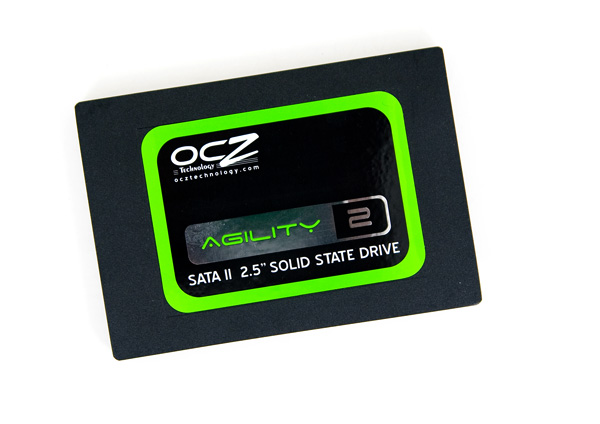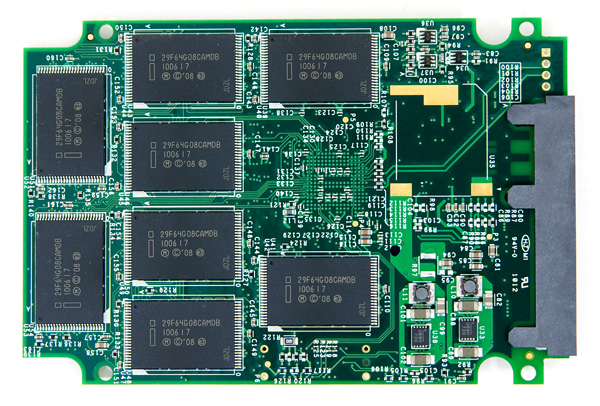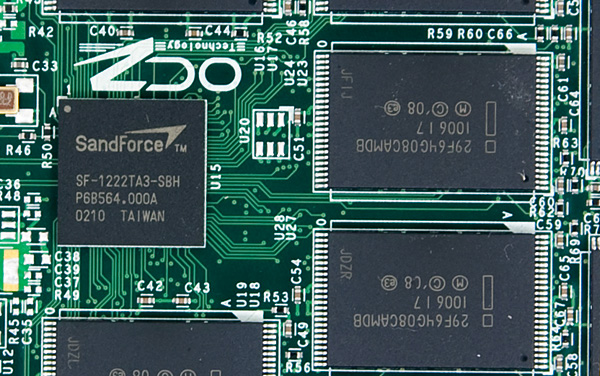OCZ's Agility 2 Reviewed: The First SF-1200 with MP Firmware
by Anand Lal Shimpi on April 21, 2010 7:22 PM ESTOCZ's Agility 2 and the SF-1200
Relegating Indilinx to the bottom of the pyramid for now is a bold move for OCZ. Considering how much business OCZ has given Indilinx over the past year I don’t expect that they are very happy over this move.
SandForce’s architecture is on a different level from what we’ve seen from Indilinx. While the Vertex could be viewed as an Intel alternative, OCZ’s Vertex 2 and Agility 2 are designed to offer better-than-Intel performance and as such they actually command a higher dollar-per-GB rate.

Both the Vertex 2 and Agility 2 are based on SandForce’s SF-1200 controller. I’ve described the differences between this and the SF-1500 in detail here. It boils down to a bunch of enterprise class features missing and lower sustained small file random write speed on the SF-1200 vs. the 1500.
The Vertex 2 retains the small file random write performance of the SF-1500, while the Agility 2 is a standard SF-1200 implementation. According to SandForce, the Agility 2 is representative of how all other SF-1200 based SSDs will perform using the 1200’s current mass production firmware (more on this later).


Note the missing super cap, that's a feature of enterprise SF-1500 designs
OCZ sent in their Agility 2 for review, arguably the more interesting of the two since we already have an idea of how the Vertex 2 will perform. Similar to previous Agility drives, the new A2 shaves a small amount off the retail price of the Vertex 2 in exchange for lower performance:
| OCZ SandForce Drive Pricing (MSRP) | |||||
| 50GB | 100GB | 200GB | |||
| OCZ Agility 2 | $204.99 | $379.99 | $719.99 | ||
| OCZ Vertex 2 | $219.99 | $399.99 | $769.99 | ||
The Agility 2 ships with a 2.5" to 3.5" drive sled for use in desktops. If you use this sled the SATA ports won't line up with drive trays in systems like the Mac Pro.
Inside the drive itself we find SandForce’s SF-1200 controller and no external DRAM. SandForce’s architecture attempts to solve the issue of NAND write amplification by simply writing less to the drive through compression/deduplication techniques. With less data to keep track of, a large external DRAM isn’t necessary - assuming the data being written is easily reduced by SandForce’s algorithms.
SandForce also claims that its reduced write amplification could enable the use of cheaper NAND on these drives. It’s an option that some manufacturers may take however OCZ has committed to using the same quality of NAND as it has in the past. The Agility 2 uses 34nm IMFT NAND, presumably similar to what’s used in Intel’s X25-M G2.

The Agility 2 sample OCZ sent had the first SF-1200 mass production firmware (v3.0.5) from SandForce on it with full TRIM support. The Agility 2 should begin shipping to etailers later this month.










60 Comments
View All Comments
529th - Thursday, April 22, 2010 - link
Some people are curious about the Vertex LE 50g version. Yes, I've read the Vertex LE 100g review :)50g Vertex LE: http://www.newegg.com/Product/Product.aspx?Item=N8...
New Egg's description says "For enthusiasts w/ up to 15,000 4KB random write IOPS" which would suggest the controller is the SF 1200 where as the Vertex LE SSD drives are suppose to have the SF 1500 controller which will do ~ 30,000 4kb so the inconsistency brings up curiosity. To make matters worse, The OCZ website says they use the SF 1500 controller. Which I vaguely recall someone saying they asked OWC which controller they were using for their OWC Mercury Extreme SSD drives and OWC's response was that they didn't know....
willscary - Thursday, April 22, 2010 - link
Originally, I was told by Customer Service that he "did not know", but after pressing for an answer and a breif period on hold, he returned and told me that all current and future Mercury Extreme SSDs would utilize the Sandforce 1200 controller.I was very angry at this "bait and switch" and returned my SSDs. Actually, they were in transit and I had OWC recall them. I have not yet received credit for them although they returned to OWC early Tuesday morning.
I will also say that OWC did send confirmation of the returns and said that the credit would be processed by the end of the week, so all is not bad.
I was asked "what the big deal was" on another thread. The way I see it, it would be like ordering an expensive sports car with a V6 and having it arrive with a turbocharged 4 cylinder. The performance may be the same, but there would then be the possibility of added maintenance costs, lesser reliability and a shorter lifespan. Add to that that the dealer would tell me that even though the smaller turbo option was $1,000 less than the V6, I should pay the same because performance really would be nearly identical.
Just my thoughts.
DanNeely - Thursday, April 22, 2010 - link
15k IOPs is higher than the SF1200 supports with a normal firmware. More likely I think would be something similar to intels 40GB drive where only half the controllers flash chip ports are filled and a full speed SF controller.poeticjustic - Thursday, April 22, 2010 - link
That was a really helpful and thorough article. Thank you for all this info.a few things that i wanted to ask.
-On the random read/write speed page and specifically on the 4k aligned random write, we don't see anywhere the intel x25-E performance. Obviously that is because the testing of the x25-E was performed in the past, when this kind of test wasn't performed. Is it safe to assume that the performance of the x25-E would be quite close to that of the 4k random write test (around 48MB/s)?? Since we see that mostly the new controllers are mostly affected.
-Furthermore, at least from what i've seen on eshops around in my country, the price of the z-drive m84 250GB and 500Gb has come closer to that of sata ssds. Still they are more expensive of course, but wouldn't it be a good idea to start seeing some z-drive performance on those tables for a direct comparison with the ssds and see whether the difference in their performance is bigger than the difference in their price? Just a thought.
Making an extra remark on the performance of SF controller during already compressed data plus the the random data perormance table was a pretty important addition and something we should pay attention to.
Thank you once again for a well built article.
eaw999 - Thursday, April 22, 2010 - link
correct, the x25-e, like -m, isn't affected drastically by alignment. you can expect slightly higher numbers with alignment, but nothing jaw-dropping. on the other hand, the x25-e positively rips at random writes at high queue depths, but that's not something you're likely to see often in desktop usage.krazyderek - Thursday, April 22, 2010 - link
When does this ever happen? isn't that sentence an oxymorron, the only thing i can think of it if you were installing several applications at the same time? and it would depend on the applications being installed too, since i think i remember hearing that games are very sequential nowkrazyderek - Thursday, April 22, 2010 - link
I DO see the importance when dealing with pre-compressed files like pictures and videos, i agree it would be nice to see a 0% 50% and 100% compressed figures to give people a good overview of things, but still, when would you see highly random sequential data?zdzichu - Thursday, April 22, 2010 - link
Sequentially speaks about data access pattern, highly random is about data itself. It is perfect description of writing movie to a disk - you are storing byte-by-byte and each byte is probably different that preceeding ones.zdzichu - Thursday, April 22, 2010 - link
I think you can skip non-aligned test in future. It is a corner case, not interesting at all.PubicTheHare - Thursday, April 22, 2010 - link
I'm pretty sure we're still 18-24 months away from having SSDs priced at a level that the average SSD-seeker is willing to spend.There will probably be an attractive price differential between what is available now and what price level the same will be available for in 12 months, but I really think it'll take a bit over a year to start seeing "attractive" pricing.
None of this stuff matters to me until Apple supports TRIM or garbage collection (I believe this is "OS-agnostic" TRIM, right?) comes to the drives with the best firmware and price/usable GB.
I just want a 256-300 GB SSD that I can leave 15% unpartitioned and throw into a MBP. I want it to scream.